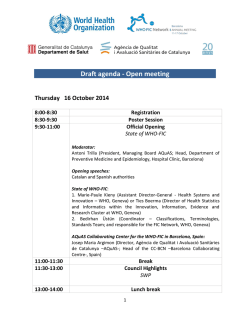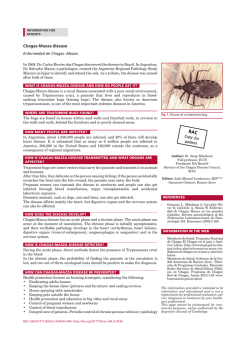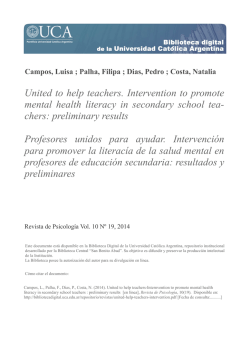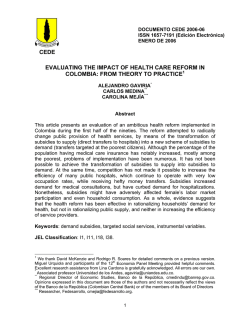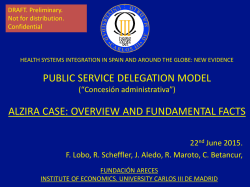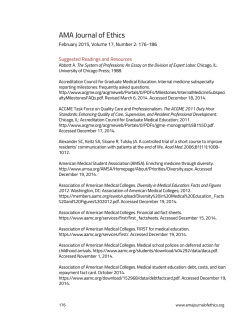
Comment The right to health - Asociación Latinoamericana de
Comment Interest in universal health care has recently risen thanks to the question of Universal Health Coverage as the basis for post-2015 arrangements. However, these terms should be carefully examined because they acquire different connotations according to different social, political, and financial interests. Some argue that it is possible to achieve universal coverage through social, private, or public insurance— mandatory, in various combinations, mediated by the segmentation of the population according to the acquisitive capacities of social groups. This position assumes that health is primarily a responsibility of the people, with medical care financed by individuals and employers, but not by the state, or at least not as central financial responsibility. For the state, funding could only be extended to groups in extreme poverty or at risk. The experiences of countries using the model of Universal Coverage criteria for public social insurance— such as Colombia, Mexico, and Chile—have not made substantial improvements because of their commercial orientation and welfare costs. Meanwhile the Latin American Association of Social Medicine—ALAMES—argues for the right to health for all citizens, without distinction, with the state as the guarantor of finance and administration. Cuba, with nearly 50 years of this model, and Brazil, with over 25 years of experience, show through their health indicators the possibility of implementing a policy based on law and finance, which are state funded, less costly, and extend to all people without distinction. The drive for “Universal Health Coverage” is currently very intense. Everybody seems to agree on this objective. However, it is important to stress that universal health coverage is an ambiguous term. This is particularly evident in Latin America where two different notions are used. One refers to forms of health insurance, be they voluntary or compulsory and public or private, and in variable combinations. The other refers to a single public health system—ie, a unified tax-funded health system as an obligation of the state. It is critical to distinguish between the two notions and to set uniform criteria of analysis to compare their achievements. In this context, these are: population and medical coverage in their categories of universal or segmented access and use of service and possible barriers; origin and management of health funds; type of providers; health expenditure, public and private; distribution of costs and amount of out-of-pocket expenditure; impact on public health actions and health conditions; and equity, popular participation, and transparency. Taken together, these reveal the extent to which the right to health, a widely held social value, is attained. The Latin American experience of health reform can only be understood in the context of structural adjustment that swept the subcontinent since the 1980s. Health ministries and social security institutions were profoundly weakened by these policies. Thus, the public and quasi-public health sector went through a long period of financial and resource destitution, which sparked a reform process, in most countries under the supervision of the World Bank. The hegemonic model of reform is presently the “universal” health insurance that is unlike European models. It is built on principles of the market (internal or external), commodification, managed competition, and pluralism. The most well-known examples are: Chile, with compulsory insurance and parallel private and public systems; Colombia, with compulsory insurance and competition between multiple fund managers and providers; and Mexico, with a mixed system of compulsory (social security) and voluntary (Seguro Popular) insurance, theoretically with separation between regulation, fund-management/service purch asing and provision functions, but in practice with very limited direct participation of the private sector. The three systems have different health packages according to the amount of the premium, public subsidies, and transactional costs.1–3 Although high population coverage is claimed, none of the three systems has achieved it—eg, Mexico, with an estimated 20% without insurance coverage.4 There is also a methodological problem, since “coverage” is taken to mean “insurance coverage”, other aspects of public coverage are not contemplated when figures are given for progress, a therefore controversial indicator used in the 2000 World Health Report to classify “performance”. Medical coverage—ie, health interventions covered by insurance—is usually limited to “basic packages” that translate into limited and unequal access to and use www.thelancet.com Published online October 16, 2014 http://dx.doi.org/10.1016/S0140-6736(14)61493-8 Turnley for Harper’s/Corbis The right to health: what model for Latin America? Published Online October 16, 2014 http://dx.doi.org/10.1016/ S0140-6736(14)61493-8 1 Comment of necessary services.5–7 This problem is compounded by the unfair geographic and social distribution of resources,6–8 which affects underserved groups and regions. Additionally, limited packages promote private complementary health insurance or an additional fee.7,9,10 The logic of explicit packages with copayments and the requirement to pay for services not covered by insurance, the unfair distribution of services, and the difficulty of regulating private fund-managers and providers have direct impacts on the use of services or out-of-pocket expenditure. For instance, in Colombia these restrictions have caused tens of thousands of protection writs against the State since they infringe the constitutional right to life.11 Another graphic example is Mexico, where for one peso paid out of pocket by its beneficiaries, Seguro Popular spends 0·93 pesos.4 Chile tried to resolve this problem with AUGE, which grants a fixed time limit to address a number of common and severe diseases, AUGE has increased timely access to treatment for these diseases but the lack of public sector capacity to meet the demand has spurred the transfer of public resources to private providers, thereby being detrimental to other not-AUGE diseases.12 Health expenditure, both public and private, has increased in most cases where health insurance reforms are implemented—around 2% of GDP in Colombia3 to less than 1% of GDP in Mexico.4 Several problems should be considered. One is that a considerable part of the new resources favours the private sector or are spent on transactional costs. The bankruptcy of the Colombian social security system is also marked by gross corruption, as has been stated by the Constitutional Court13 and the Accountability Office.14 Furthermore, in fragmented systems like Mexico, the budget increase has generated distributional battles4 that may result in a loss of rights for large groups of the population. The person-centred insurance model tends to have a negative impact on public health because its pluralist focus weakens epidemiological surveillance and collective interventions.15,16 Finally, there is no consistent evidence that population health has improved17 and some critics even maintain that health impact should not be a criterion of evaluation.17 This concise analysis shows that universal health insurance in Latin America does not grant the right to health, understood as equal access to the necessary services for equal need. 2 By contrast with the intrinsic restrictions of universal health insurance, the problems of the single public health system (SPHS) are operational or concern implementation. The SPHSs are de-commodified, integrated, and publicly funded health systems, granted by the State. In Latin America, the two leading examples are Brazil18 and Cuba, but recently countries such as Venezuela,19,20 Bolivia,21 and Ecuador,22 using a more comprehensive frame, such as “living well”, “vivir bien”, or “sumac kawsay”, have adopted this reform model after years of neoliberal health policy. This approach has generally been legislated into Constitutions and is the result of a broad-based social mobilisation. This paradigm offers, by definition, complete population and medical coverage. The access and use of services then depends mainly on different type of barriers: geographic, cultural, bureaucratic, and the attitude of the health team. These barriers are particularly frequent in newly established systems and in poor countries given their lack of physical and human resources. Nevertheless, access has broadened massively in all these countries and Brazil is close to universal coverage (97%), with 80% depending for access exclusively on the single public health system. 98% of those searching for medical care receive it.23 A second advantage of the SPHSs is that the much discussed pooling of risks and funds is complete since they have a single health fund. A common shortcoming of the SPHSs is that public institutions with salaried staff are insufficient, which obliges contracting with private providers for the treatment of complex interventions. This approach drains financial resources from the public budget and also increases contracting of private complementary health plans.24 Public health expenditure has increased with the implementation of the SPHSs, but even when regulatory legislation exists public expenditure has proven to be vulnerable to economic instability. Out-of-pocket expenditure depends largely on the capacity of the public system to provide services and drugs and on the contracting of complementary health plans. In this respect, for example, it should be stressed that Brazilian insurance companies are selling low-coverage plans for profit and then transfer patients to the public system for most treatments.25 Since SPHSs offer integrated care they have better conditions to promote and implement public health actions, such as health education, promotion, prevention, www.thelancet.com Published online October 16, 2014 http://dx.doi.org/10.1016/S0140-6736(14)61493-8 Comment and early detection of disease. They are also better suited to intersectoral action with other ministries and tend to form part of progressive social and economic policies that address a range of social determinants of health. Although it is problematic to prove causality between health service organisation and improved health conditions, countries with SPHSs have shown advances in population health and in life security.26,27 SPHSs in Latin America still have problems to resolve, but are on their way to grant the right to health. Today, popular and social participation in health is an unavoidable and much to be appreciated quality. The health insurance model claims social participation, given that the payer-provider split is supposed to allow the population to “vote with its feet” through choice. Social participation is at the heart of SPHSs for two reasons. One is that in Latin America it is the result of massive social participation, and the other is that participation is institutionalised through health councils at all levels. Intercultural relations are also important in Latin America, together with the concepts of “gender”, “work”, and “environment”. These ideas need to be considered in the construction of health policies and strategies. Intercultural relations are important in the debate over universal health insurance and SPHS because the basic focus of the health insurance model is on the individual and the biomedical, while the SPHS is constructed on the basis of the universal wellbeing of the person, the family, and the community where people live and develop their potential. In the community, ancient and popular cultures and knowledge allow the health sector to build respectful relationships with the population in which promotion and prevention form part of everyday life.28 To end, we want to state that ALAMES does not pretend to represent the view of all “civil society”. We regret that civil organisations were offered only a single contribution in a crucial debate that concerns the use of “Universal Health Coverage” as an instrument to strengthen private insurance. *Nila Heredia, Asa Cristina Laurell, Oscar Feo, José Noronha, Rafael González-Guzmán, Mauricio Torres-Tovar ALAMES, Casilla Postal 7021, La Paz, Bolivia (NH); ALAMES, Callejón de Chilpa 23–9, Col. La Concepción, Coyoacán, Mexico DF, Mexico (ACL); ALAMES, Maracay, Aragua, Venezuela (OF); ALAMES, Centro Brasileiro de Estudos de Saúde (CEBES), Manguinhos, Rio de Janeiro, Brazil (JN); ALAMES, Departamento de Salud Pública, Facultad de Medicina, Universidad Nacional Autónoma de Mexico, Ciudad Universitaria, Mexico DF, Mexico (RG-G); and Universidad Nacional de Colombia, ALAMES e IAHP, Bogotá, Colombia (MT-T) [email protected] We declare no competing interests. 1 2 3 4 5 6 7 8 9 10 11 12 13 14 15 16 17 18 19 20 21 OPS. Salud en Sudamérica. Panorama de la situación de salud y de las políticas y sistemas de salud. Washington, DC: Organización Panamericana de la Salud/ Organización Mundial de la Salud, 2012. Laurell AC. Sistemas Universales de Salud: Retos y Desafíos. 2013. http:// issuu.com/isagsunasur/docs/sistemasuniversalesdesaludretosydesafios_/1 (accessed Oct 6, 2014). Torres-Tovar M. Modelo de salud colombiano: exportable, en función de los intereses de mercado. Sáude em Debate 2008; 32: 207–19. Laurell AC. Impacto del seguro popular en el sistema de salud mexicano. Buenos Aires: CLACSO, 2013. http://biblioteca.clacso.edu.ar/clacso/clacsocrop/20130807020931/Impacto del Seguro Popular.pdf (accessed Jan 14, 2014). Consejo Nacional de Evaluación. Evaluación estratégica de proteccón social en México. 2012. http://web.coneval.gob.mx/Informes/Evaluacion/ Estrategicas/Evaluacion_Estrategica_de_Proteccion_Social_en_Mexico.pdf (accessed Oct 6, 2014). Alvarez LS, Salmon JW, Swartzman D. The Colombian health insurance system and its effect on access to health care. Int J Health Serv 2010; 41: 355–70. Fondo Nacional de Salud Protección social en salud en Chile. Santiago de Chile: Fondo Nacional de Salud, 2007. Hernández M, Torres-Tovar M. Colombia’s new health reform: helping keep the financial sector healthy. Soc Med 2010; 5: 177–81. Lakin J. The end of insurance? Mexico’s Seguro Popular 2001–2007. J Health Polit Policy Law 2010; 35: 456–71. Yepes Lujan FJ, Ramírez Gómez M, Sánchez Gómez LH, Ramírez ML, Jaramillo Pérez I. Luces y Sombras de la Reforma de la Salud en Colombia. Bogotá: Mayol Ediciones S.A, 2010. Gianella-Malca C, Parra-Vera O, Ely Yamin A, Torres-Tovar M. Democratic deliberation or social marketing? The dilemmas of a public definition of health in the context of the implementation of Judgment T–760/08. 2009. http:// www.hhrjournal.org/2009/08/24/deliberacion-democratica-o-mercadeosocial-los-dilemas-de-la-definicion-publica-en-salud-en-el-contexto-delseguimiento-de-la-sentencia-t-760-de-2008 (accessed June 28, 2013). Missoni E, Solimano G. Towards universal health coverage: the Chilean experience. In World Health Report (2010) background paper, no 4. Geneva: World Health Organization, 2010. Corte Constitucional. Sala Especial de Seguimiento a la Sentencia T-760 de 2008. 2012. http://www.corteconstitucional.gov.co/T-760-08/ comunicados/Comunicado%20del%2016%20de%20abril%20de%20 2012%20%28Sala%20Especial%20de%20Seguimiento%20a%20la%20 sentencia%20T-760%20de%202008%29.pdf (accessed Oct 6, 2014). Morelli S. Reflexiones sobre el control en el sector Salud. Sistema Nacional de Salud. Infinitamente rico en su miseria. Economía Colombiana No. 336 Revista de la Contraloría General de la República. 2012. http://www. contraloriagen.gov.co/web/guest/herramientas/economia-colombiana (accessed Oct 6, 2014). Knaul F, González-Pier E, Gómez-Dantés O. The quest for universal health coverage: achieving social protection for all in Mexico. Lancet 2012; 380: 1259–79. Groote TD, Paepe PD, Unger JP. Colombia: in vivo test of health sector privatization in the developing world. Int J Health Serv 2005; 35: 125–41. Giedion U, Alfonso EA, Díaz Y. The impact of universal coverage schemes in the developing world: a review of the existing evidence. Washington, DC: World Bank, 2013. Paim J, Travassos C, Almeida C, Bahia L, Macinko. The Brazilian health system: history, advances, and challenges. Lancet 2011; 377: 1788–97. Feo O, Pasqualina C. La salud en el proceso constituyente venezolano. 2004. http://scielo.sld.cu/scielo.php?script=sci_arttext&pid=S086434662004000200008&lng=es (accessed June 25, 2013). Muntaner C, Guerra Salazar R, Benach J, Armada F. Venezuela’s Barrio Adentro: an alternative to neoliberalism in health care. Int J Health Serv 2006; 36: 803–11. Asamblea Constituyente de Bolivia. Constitución Política del Estado Plurinacional de Bolivia. October, 2008. http://bolivia.infoleyes.com/ shownorm.php?id=469 (accessed June 28, 2013). www.thelancet.com Published online October 16, 2014 http://dx.doi.org/10.1016/S0140-6736(14)61493-8 3 Comment 22 ISAGS. Sistemas de salud en suramerica: desafíos para la universalidad, la integralidad y la equidad. Rio de Janeiro: Instituto Suramericano de Gobierno en Salud, 2012. 23 Ministerio de Salud. 2012. http://www.brasil.gov.br/sobre/salud/ atendimento/que-es-sus-1/br_model1?set_language=es (accessed Feb 7, 2013). 24 Ocké-Reiss O. SUS o desafio de ser único. Río de Janeiro: Editora FIOCRUZ, 2012. 25 CEBES. Renovar a Política Preservando o Interesse Público na Saúde. 2012. http://www.cebes.org.br/media/file/Renovar%20a%20Politica%20 Preservando%20o%20Interesse%20Publico%20na%20Saude.pdf (accessed May 8, 2013). 4 26 Ministerio de Saúde. 2008. http://portal.saude.gov.br/portal/saude/ profissional /visualizar_texto.cfm?idtxt=32203&janela=1 (accessed Feb 25, 2013). 27 Armada F, Muntaner C, Chung H, Williams-Brennan L, Benach J. Barrio Adentro and the reduction of health inequalities in Venezuela: an appraisal of the first years. Int J Health Serv 2009; 39: 161–87. 28 Ministerio de Salud y Deportes. Plan Estratégico Sectorial de Salud 2006–2010 y 2011–2015. http://www.minsalud.gob.bo/index.php/ viceministerios/vice-medicina-tradicional (accessed Oct 6, 2014). www.thelancet.com Published online October 16, 2014 http://dx.doi.org/10.1016/S0140-6736(14)61493-8
© Copyright 2025
